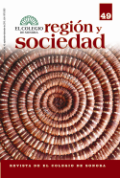 |
 |
 |
 |
 |
 |
 |
 |
 |
 |
 |
 |
Abstract
Although socio-spatial differentiation is a characteristic of tourist cities, it has generally not been studied. This article analyses the different patterns of socio-spatial segregation in Puerto Vallarta, Mexico. Using different indices, the results show that there is significant segregation in terms of water supply and sewage infrastructure. Thus, the main conclusion is that government should be more involved in reducing social and spatial disparities.
References
Anton, S. 1999. La urbanización turística. De la conquista del viaje a la reestructuración de la ciudad turística. Documents d Analisi Geografica (32): 17–43.
Boltvinik, J., y A. Damián. 2001. La pobreza ignorada. Evolución y Características. Papeles de Población 7 (29): 21–53.
Bringas–Rábago, N. L. 2002. Baja California and California's Merging Tourist Corridors: The influence of Mexican Government Policies. The Journal of Environment Development 11 (3): 267–296.
Brown, L., y S. Y. Chung. 2006. Spatial Segregation, Segregation Indices and the Geographical Perspective. Population, Space and Place 12: 125–143.
CEPAL. 2003. Panorama social de América Latina, 2002–2003. Santiago de Chile: CEPAL.
Dupont, V. 2004. Socio–spatial Differentiation and Residential Segregation in Delhi: A Question of Scale? Geoforum 35 (2): 157–175.
Everitt, J., B. H. Massam, R. M. Chávez–Dagosto, R. Espinosa y E. Andrade. 2008. The Imprints of Tourism on Puerto Vallarta, Jalisco, Mexico. The Canadian Geographer 52 (1): 83–104.
Feitosa, F. F., G. Monteiro, A.M.V., Koschitzki, T., y M. P. S. Silva. 2007. Global and Local Spatial Indices of Urban Segregation. International Journal of Geographical Science 21 (3): 299–323.
Fuentes, C., y L. E. Cervera. 2006. Land Markets and its Effects on the Spatial Segregation: The Case of Ciudad Juárez, México. Estudios Fronterizos 7 (13): 43–62.
Gormsen, E. 1997. The Impact of Tourism on Coastal Areas. GeoJournal 42 (1): 39–54.
Gutiérrez, M. T., y J. González.1999. Las costas mexicanas y su crecimiento urbano. Investigaciones Geográficas 40: 110–126.
Hiernaux–Nicholas, D. 2005. Competitividad de las ciudades turísticas de México en el contexto global. En Ciudades del siglo XXI: ¿competitividad o cooperación?, editado por C. Arce, Enrique Cabrero y Alicia Ziccardi. México: Cámara de Diputados–Centro de Investigación y Docencia Económicas–Miguel Ángel Porrúa.
INEGI. 2009. II Conteo general de población y vivienda, 2005: microdatos. Disco compacto, editado por el INEGI.
––––––––––. 2008. Catálogo histórico de localidades. www.inegi.org.mx (13 de marzo de 2009).
––––––––––. 2005. XII Censo general de población y vivienda, 2000: microdatos. Disco compacto, editado por el INEGI.
––––––––––. 2005. XI Censo general de población y vivienda, 1990: microdatos. Disco compacto, editado por el INEGI.
––––––––––. 2005. Censos económicos, 1999. Disco compacto, editado por el INEGI.
––––––––––. 2005. Censos económicos, 2005. Disco compacto, editado por el INEGI.
Judd, Deniss R. 2003. El turismo urbano y la geografía de la ciudad. EURE XXIX (87): 51–62.
Lash, Scott y John Urry. 1998. Economías de signos y espacio: sobre el capitalismo de la posorganización. Buenos Aires: Amorrortu.
López, Álvaro, Judith Cukier y Álvaro Sánchez. 2006. Segregation of Tourist Space in Los Cabos, México. Tourism Geographies. An International Journal of Tourism Space, Place and Environment 8 (4): 359–379.
Márquez, A. 2007. La expansión del turismo costero en Bahía Banderas, Nayarit: un análisis de deterioro ambiental. Tesis de doctorado en geografía, Universidad Nacional Autónoma de México.
Martori, J., K. Hoberg y J. Surinach. 2006. Población inmigrante y espacio urbano: indicadores de segregación y pautas de localización. EURE XXII (97): 49–62.
Morales, J., y J. L. Pérez. 2006. Crecimiento poblacional e instrumentos para la regulación ambiental de los asentamientos humanos en los municipios costeros. Gaceta Ecológica 79: 53–77.
Mullins, Patrick. 1991. Tourism Urbanization. International Journal of Urban and Regional Science 15 (3): 326–342.
Padilla y Sotelo, S. 2000. La población en la región costera de México en la segunda mitad del siglo XX. Investigaciones Geográficas 81: 95.
Peters, P., y E. Skop. 2007. Socio–spatial Segregation in Metropolitan Lima, Peru. Journal of Latin American Geography 6 (1): 149–171.
Rivera–Arriaga, E., y G. Villalobos. 2001. The Coast of Mexico: Approaches for its Management. Ocean and Coastal Management 44 (4): 729–756.
Rodríguez, Jorge y Camilo Arriagada. 2004. Segregación residencial en la ciudad latinoamericana. EURE XXIX (89): 5–24.
SECTUR. 2003. Turismo interno. Los viajes de los residentes en México dentro del país. México: SECTUR.
SEDESOL, CONAPO e INEGI. 2005. Delimitación de las zonas metropolitanas de México. México: SEDESOL, CONAPO, INEGI.
Vilalta, Carlos. 2008. Comentarios y mediciones sobre la segregación espacial en la Ciudad de México. Estudios Demográficos y Urbanos 23 (2): 375–413.
Wilson, T. 2008. Economic and Social Impacts of Tourism in Mexico. Latin American Perspectives 35 (3): 37–52.
Wong, D. W. S. 2004. Comparing Traditional and Spatial Segregation Measures: A Spatial Scale Perspective. Urban Geography 25 (1): 66–82.
––––––––––. 2003. Spatial Decomposition of Segregation Indices: A Framework Toward Measuring Segregation a Multiple Levels. Geographical Analysis 35 (3): 179–194.
––––––––––. 1999. Geostatistics as Measures of Spatial Segregation. Urban Geography 20 (7): 635–647.
––––––––––. 1993. Spatial Indices of Segregation. Urban Studies 30 (3): 559–572.
–––––––––– y W. K. Chong. 1998. Using Spatial Segregation Measures in gis Statistical Modeling Packages. Urban Geography 19 (5): 477–485.
WTO. 2008. International Trade Statistics. Ginebra.
Xiao, H., y S. L. J. Smith. 2006. The Making of Tourism Research. Insights from a Social Sciences Journal. Annals of Tourism Research 33 (2): 490–507.
Open access policy
The authors who publish in región y sociedad accept the following conditions:
In accordance with the copyright laws, región y sociedad recognizes and respects the authors’ moral rights, as well as the ownership of property rights, which will be transferred to the journal to disseminate the articles in open access. región y sociedad does not charge the authors for submitting and processing articles for publication.
All the texts published by región y sociedad —with no exception— are distributed under a Creative Commons license 4.0 Attribution – Noncommercial (CC BY-NC 4.0 International), which allows third parties to use the publication as long as they mention the works’ authorship and the first publication in this journal.
The authors can enter into independent and additional contractual agreements for the nonexclusive distribution of the version of the article published in región y sociedad (for instance include it into an institutional repository or publish it in a book) as long as they clearly indicate that the work was published for the first time in región y sociedad.
For all the above, the author(s) must send the Letter of transfer of property rights of the first publication duly filled in and signed by the author(s). This letter can be sent by e-mail as a PDF to: region@colson.edu.mx






